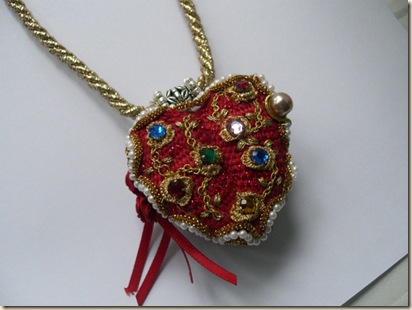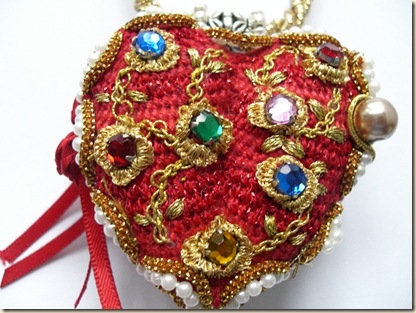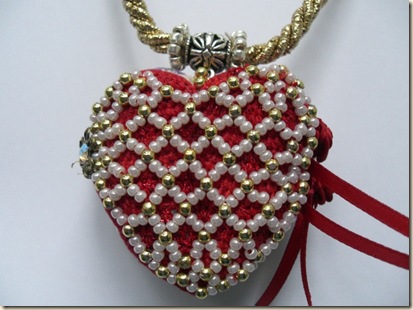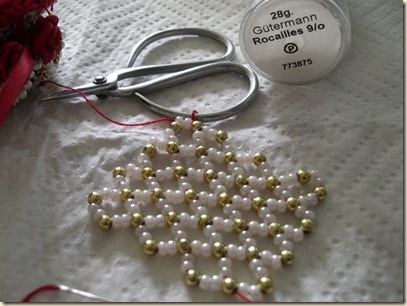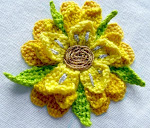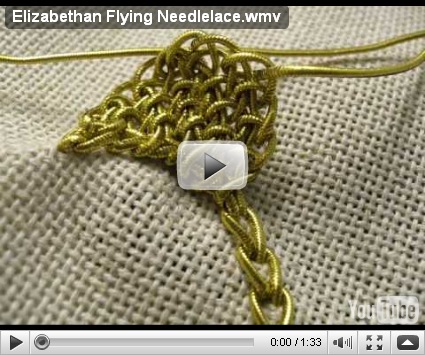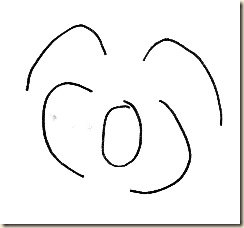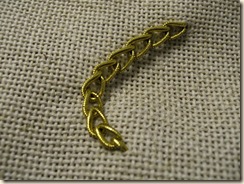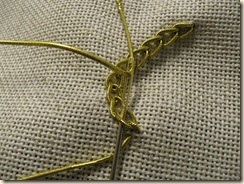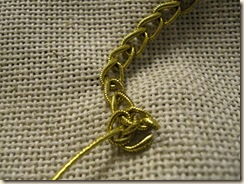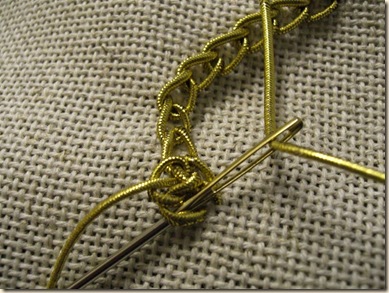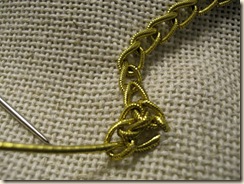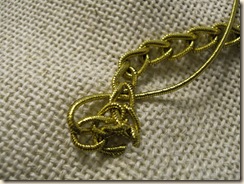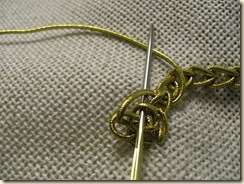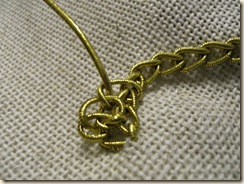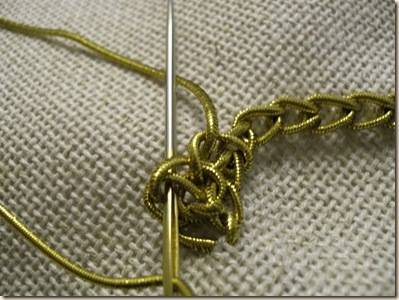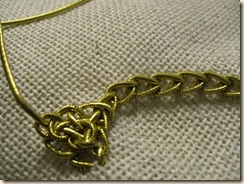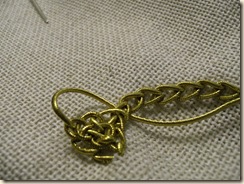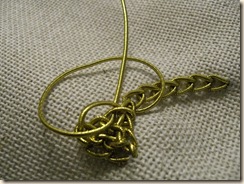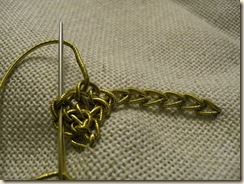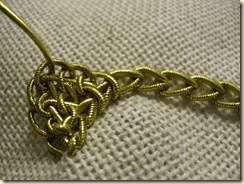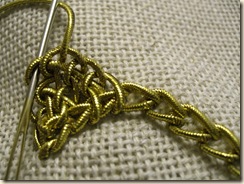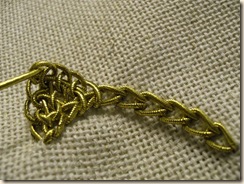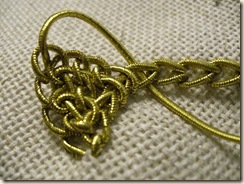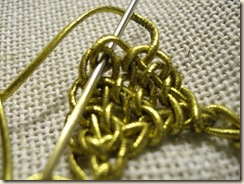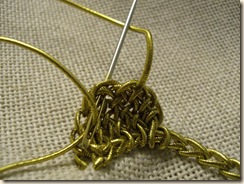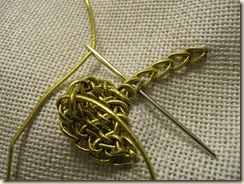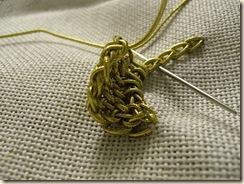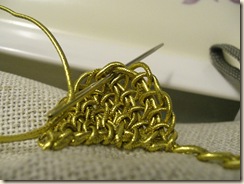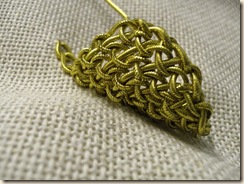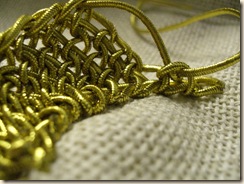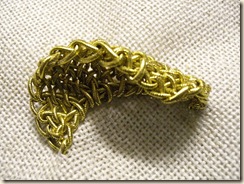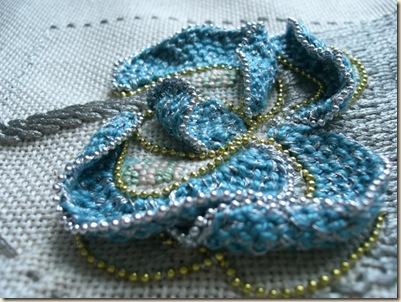So I thought I would use some of the techniques I’ve learned so far to work on my own contemporary rose pattern.
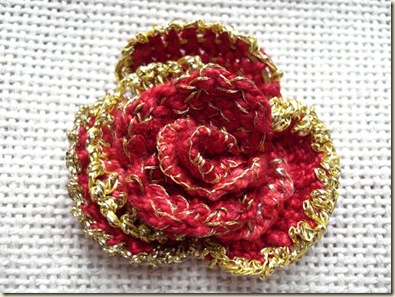
I come back to this motif often using different methods and this time I wanted to devise a workable solution, primarily, for the conundrum that is the rose centre. I’ve been looking at ways to try and achieve a more realistic centre because if you look inside a rose you can see at the centre there’s always a tightly wound coil of new fresh petals about to open.
Ideally I would have preferred this practice version to be much smaller but I was using some cotton perle and that’s a bit chunky for my grandiose ambitions. What’s interesting here is I can see several things happening that simultaneously encourage me and give cause for concern. First off, even though it’s completely embroidered it does look a lot like a crocheted or maybe Brazilian rose.
The other thing is that, like The Orange (see earlier relevant post) it is very Spanish. I should explain that I’m partly of Iberian extraction and you know I never realised until now, since dipping my tentative toe in with using gold metallic thread, how much all that Spanish decorative input has subliminally informed my aesthetic appreciation. Ruby red and gold combos are big in Spain; jewellery; bull-fighting costumes; religious iconography, especially the heavily gold-worked robes on the statues of Saints.
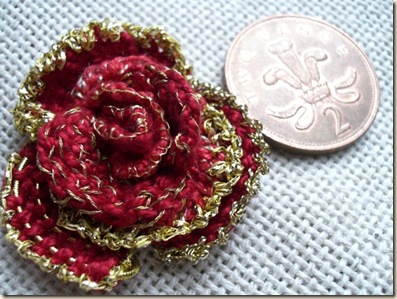
Now the idea of anatomically realistic embroidered rose centres is a bit of a challenge. You can either suggest it or conceal it but to really describe it, you need to go dimensional.
Last year I decided I wanted to try and find my own way of somehow building-up the central stitches. Often to find solutions to a particular problem its good to look outside, at other disciplines. In this case I found it helpful to look at the simplified ‘code’ captured so well on jewellery and porcelain designs, like here:
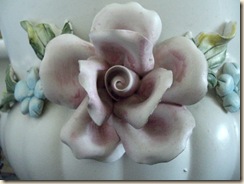
This is a very clear simplification of a 3-d rose. I love this potholder and I especially like the way the edges of the petals fray out, just like the real thing. Well, I wanted to get that idea down with a bit of thread. I didn’t sketch any preliminary drawings or anything, I just picked up from where I left off last year, but on a larger scale.
From what I’ve discovered so far about perpendicular Detached Buttonhole (DBH) is that it curls in a particular way however, Single Detached Buttonhole – Brussels Stitch - because its mesh/lattice is that much finer, produces an even more delicate petal rendition. Now I quickly discovered that if I make petals using both types of stitch, structurally, they complement each other really well and that’s useful for shaping.
Perhaps its an exaggeration or maybe not, but I do think that when you work with thread in this 3-d way its a bit more than sewing and has a lot to do with the discipline of soft-sculpture…for me anyway…
So I decided to use Brussels stitch for the two central areas, then some DBH, then some more Brussels.
You’re watching for the way each kind of petal bends and you add, either a not-so-curly one next time, or a thicker one, so it just grows, organically, like real roses. If you notice real rose petals are not uniform in the way they break out. By making some petals thick and some thin, I can ‘sort of’ mimic that natural formation. I should add, that I agree a lot with watch *Grace Christie (writing as Mrs Archibald Christie) said all those years ago, that even when you are sewing life-like objects, “the sewing should always show through”.
Here’s the basic pattern:
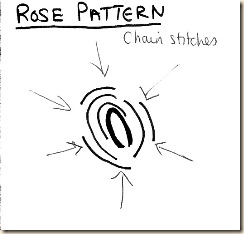
I didn’t sew all the chain stitch foundation rows in the beginning, just the centre and 3 outer rows, then I filled in the gaps with more petals. Here’s a diagram of how the centre should look:
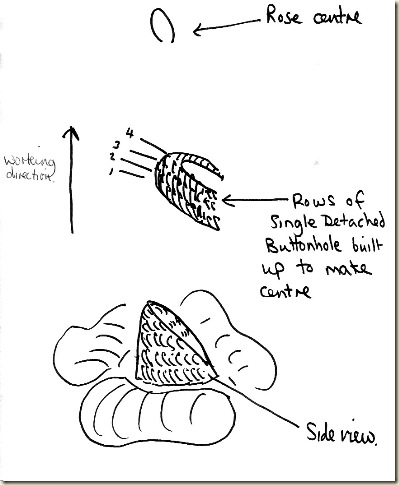
Now unfortunately I don’t have any photos of the first all-important stage because it was, after all an experiment and I was surprised when it worked, because last year I tried it and it went a bit funny. The improvement I made this year, which I learned from The Bag’s blue flower, is to use just a normal chain stitch foundation, then after that, its very easy to work with.
I should add, to fully understand this post, you might find it useful to see my recent video on Single Detached Buttonhole, (you don’t have to but), it explains that if you take the orientation of this stitch into account, then you can use the concept for a lot of things. Now in the video it shows you that when working flat, if you want Brussels to ‘behave itself’ you turn it upside down and bring the thread to the front. Well, for 3-D Brussels, the solution is to simply ‘turn the work’ on each change of row, so that way: ‘left side will become the right and visa versa’.
Now the other thing to remember about working in this way is that unlike ‘needle weaving’ you’ll need to support the work as you go along, in such a way so as to temporarily create a ‘loom’ idea with your fingers. That might sound difficult, but really it isn’t as all you’re doing is putting your index finger BEHIND the stitches as you go along to give them something to rest on. This part needs to be explained because if you don’t do that, then you might just pull everything too hard and the structure kind of collapses.
This is how I started:
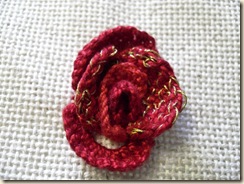
Here is the index finger behind the work...
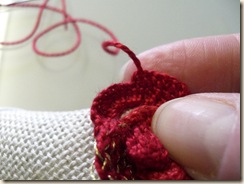
Below you can see I’ve pulled the stitch through and I’m nearing the end of that row. The petal will spring up when you’ve finished, especially due to the fact that AFTER the last stitch, you PEG it down into the fabric. This detail adds to the definition of the curl and pulls the whole thing forward. I’ve discovered, Brussels stitch fans-out much more than perpendicular DBH and the pegging down part really adds to its final shape.
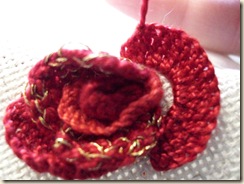
Below is the fun part. Here’s I’m using my own solution to not having any Milliary Wire. First I whipped the edge of the petal with gold. Then I went into the top of each Whip stitch and added a Trellis stitch. You get a neat knobbly effect like that, especially so with this particular twisted foil (Anchor). I love Milliary wire and can see in the *book I’m reading that this type of wavy-edging idea was used around the motifs on some Elizabethan curtains, using green silk thread. It’s not Pekinese stitch, from what I can make out, but the image isn’t clear enough for me to say for sure how they did it, so here’s my stab at it anyway.
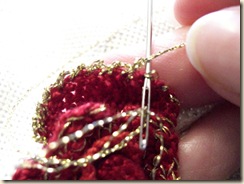
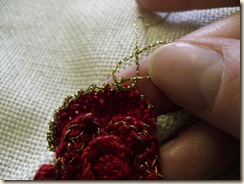

The rest of the embellishing is just whatever took my fancy really, bit of elastic, bit of Knotted Buttonhole, bit of straight Buttonhole…
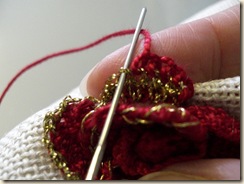
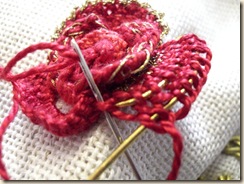

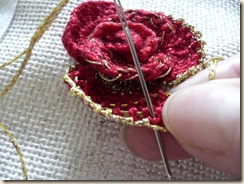
Now you might wonder what on earth this thing is doing here, well, this is how the rose centre puzzle started out.
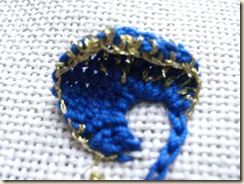
For the second attempt, you can see I kind of gave up and just did some Tent stitches with gold knitting yarn for the centre. The weird thing I made below served to show me I really needed to consolidate my aims but the good thing is that the gold Tent work does manage to cover all the linen well, so that’s another type of flower centre solution up my sleeve…
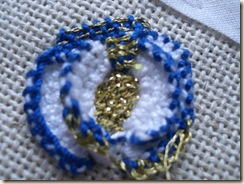
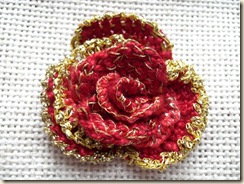
g2g !
* Mrs Archibald Christie ‘Stitches & Samplers’ 1920
* The Victoria & Albert Textile Collection – Embroidery in Britain from 1200 to 1750.
03 May 2010 - I'm doing further work on this idea. I'm not happy with the way this trial version turned out. I've also deleted the comment I made about Taxidermy because on further consideration, its not exactly what I meant.
I don't like the look of the rose I made on this post and have considered deleting this post. It looks too much like crochet and that is not what I'm after, at all. I've been doing further experiments and basically I'm aiming for a Hybrid Tea rose but I've ended up with a Cabbage rose. Now this is not a bad thing, because Cabbage roses are Old English roses and I like the way my latest version turned out much more than this one.
Ideally I would like to delete this post, but I think it contains some useful information. I don't like the title either, as it suggests something really modern-looking when that wasn't my aim. Really all this post deals with is the unfurled central cone, a lot of the rest I've recently changed my mind on.
B.L.
